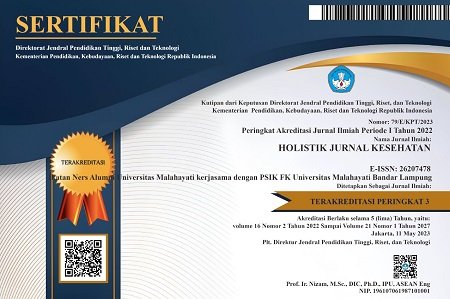Analisis survival: Pemenuhan kebutuhan penggunakan kontrasepsi pada orang dengan HIV/AIDS (ODHA)
Abstract
Background: The use of contraception in women with HIV/AIDS is one of the 4 goals of preventing HIV transmission. The use of contraception is done to prevent unwanted pregnancy and prevent transmission. However, currently the number of unmet needs for contraceptive use among WUS with HIV is high and many WUS with HIV are not exposed to contraceptive use.
Purpose: To examine the survival of WUS contraceptive use with HIV and to see differences in length of use depending on the type of contraception chosen.
Method: The research method uses a retrospective study using secondary data to assess contraceptive visits starting from the first time you become an acceptor and the last visit to receive contraceptive services. The sample taken was 105 respondents (female) from various health centers spread across Buleleng Regency. The analysis used was survival analysis using Kaplan-Meier and Kruskall Wallis to see group differences in types of contraception.
Results: The results showed that the mean and median survival was quite wide between the group using condoms, 3-month injections, MOW contraception and the group not using contraception. This is significant with a chi square value of 10.82 and a p value <0.05, namely 0.013. The type of group that uses condom contraception also has the highest mean and is significantly different from other contraceptive groups.
Conclusion: In terms of survival, PLWHA women who use condom contraception have a lifespan of 37 months or the equivalent of 3 years to become unmet need.
Keyword: Contraception; Female; People Living With HIV/AIDS (PLWHA); Unmet Need
Pendahuluan: Penggunaan kontrasepsi pada wanita ODHA merupakan salah satu tujuan dari 4 prong pencegahan penularan HIV. Penggunaan kontrasepsi dilakukan untuk mencegah kehamilan yang tidak diinginkan dan melakukan pencegahan penularan. Namun saat ini angka unmet need penggunaan kontrasepsi WUS dengan HIV masih tinggi dan banyak WUS HIV tidak terpapar oleh penggunaan kontrasepsi.
Tujuan: Untuk melihat perbedaan lama terhadap survival dalam penggunaan kontrasepsi pada wanita ODHA.
Metode: Penelitian menggunakan studi retrospektif menggunakan data sekunder untuk menilai kunjungan kontrasepsi dimulai dari awal menjadi akseptor dan terakhir berkunjung mendapatkan pelayanan kontrasepsi. Sampel yang diambil sebanyak 105 responden (wanita) dari berbagai puskesmas yang tersebar di Kabupaten Buleleng. Analisis yang digunakan adalah survival analisis dengan Kaplan-meier dan kruskall wallis untuk melihat perbedaan kelompok jenis kontrasepsi.
Hasil: Hasilnya bahwa mean dan median survival cukup lebar dari kelompok pengguna kontrasepsi kondom, suntik 3 bulan, MOW dan kelompok yang tidak menggunakan kontrasepsi. Hal ini bermakna dengan nilai chi square 10,82 dan nilai p <0,05 yaitu sebesar 0,013. Jenis kelompok pengguna kontrasepsi kondom juga memiliki mean terbanyak serta signifikan berbeda dari kelompok kontrasepsi lainnya.
Simpulan: Secara survival wanita ODHA yang menggunakan kontrasepsi kondom memiliki ketahanan selama 37 bulan atau setara 3 tahun untuk menjadi unmet need.
Keywords
References
Aini, L. N. (2013). Pilihan Kontrasepsi Pada Perempuan Penderita HIV/AIDS Di RSUD Soetomo Surabaya (Doctoral dissertation, Universitas Airlangga).
Akyunin, N. Q. (2017). Faktor Yang Berpengaruh Terhadap Unmet Need Pada Pasangan Usia Subur Dengan HIV/AIDS Di Kota Malang. Kendedes Midwifery Journal, 3(2
Badan Pusat Statistik. (2022). Data Unmet Need Pelayanan kesehatan Menurut Provinsi. Diakses dari: dari: https://www.bps.go.id/indicator/30/1402/1/unmet-need-pelayanan-kesehatan-menurut-provinsi.html
Cleland, J., Conde-Agudelo, A., Peterson, H., Ross, J., & Tsui, A. (2012). Contraception and health. The Lancet, 380(9837), 149-156.
Dejene, H., Abera, M., & Tadele, A. (2021). Unmet need for family planning and associated factors among married women attending anti-retroviral treatment clinics in Dire Dawa City, Eastern Ethiopia. PloS one, 16(4), e0250297.
Holland, D. E., Mistiaen, P., & Bowles, K. H. (2011). Problems and unmet needs of patients discharged “home to self-care”. Professional Case Management, 16(5), 240-250.
Kassie, M. D., Habitu, Y. A., & Berassa, S. H. (2021). Unmet need for family planning and associated factors among women living with HIV in Gondar city, Northwest Ethiopia: cross-sectional study. Pan African Medical Journal, 38(1).
Kementerian Kesehatan Republik Indonesia (2020). Infodatin Pusat Data dan Informasi Kementerian Kesehatan RI. Diakses dari: https://perpustakaanrsmcicendo.com/2017/05/08/infodatin-pusat-data-dan-informasi-kementrian-kesehatan-ri/
Kementerian Kesehatan Republik Indonesia (2021). Laporan Perkembangan HIV/AIDS dan Penyakit Infeksi Menular Seksual (PIMS) Triwulan I Tahun 2021 (Issue March). Diakses dari: https://siha.kemkes.go.id/portal/files_upload/Laporan_TW_I_2021_FINAL.pdf
Maulana, F. (2018). Kontribusi Badan Kependudukan dan Keluarga Berencana Nasional (BKKBN) dalam Meningkatkan Informasi Keluarga Berencana (KB) di Kota Banda Aceh (Doctoral dissertation, UIN Ar-Raniry Banda Aceh).
Megaputri, P. S., & Meriyani, D. A. (2018). Perilaku dan Strategi Negosiasi Penggunaan Kondom Oleh Pekerja Seks Kepada Pelanggannya di Bali. MIDWINERSLION: Jurnal Kesehatan STIKes Buleleng, 3(2), 189-195.
Mohammed, A., Chiroma, D., Laima, C. H., Danimoh, M. A., & Odunze, P. A. (2020). Predictors of Unmet Need for Family Planning among HIV Positive Women in Care in Federal Teaching Hospital Gombe, Nigeria. Asian Journal of Medicine and Health, 18(3), 26-33.
Nurhadi, S. (2021). Seorang wanita penjaja seks dengan infeksi menular seksual multipel dan HIV positif. Prominentia Medical Journal, 2(2), 41-52.
Rucinski, K. B., Powers, K. A., Schwartz, S. R., Pence, B. W., Chi, B. H., Black, V., & Pettifor, A. E. (2018). Longitudinal patterns of unmet need for contraception among women living with HIV on antiretroviral therapy in South Africa. PLoS one, 13(12), e0209114.
Sophia, S., Anwar, A. D., & Lestari, B. W. (2016). Husband’s support towards unmet need of HIV positive-infected women of childbearing age. Kesmas: Jurnal Kesehatan Masyarakat Nasional (National Public Health Journal), 10(4), 156-161.
Susanti, S., & Widyoningsih, W. (2019). Study fenomenologis pemilihan alat kontrasepsi pada wanita usia subur penderita HIV/AIDS. MEDISAINS, 16(3), 107-113.
Susanti, S., Sujianti, S., & Lestari, Y. A. (2021). Hubungan Usia, Tingkat Pengetahuan, dan Riwayat Penggunaan Alat Kontrasepsi dengan Pemilihan Alat Kontrasepsi pada Penderita HIV/AIDS. Jurnal Bidan Cerdas, 3(3), 103-109.
United Nations Children's Fund. (2020) UNICEF follow-up to recommendations and decisions of the forty-fifth and forty-sixth Joint United Nations Programme on HIV/AIDS Programme Coordinating Board meetings. Diakses dari: https://www.unicef.org/executiveboard/media/2776/file/2021-EB2-HIV-AIDS-EN.pdf
World Health Organization (2023) HIV and AIDS. Diakses dari:https://www.who.int/news-room/fact-sheets/detail/hiv-aids?gclid=CjwKCAiA0syqBhBxEiwAeNx9N8OBZGVXKQMy61Z1ueJHCdfDim4vpdglgHEemxzmbV83ndVY45B2EBoCvhkQAvD_BwE
Yuliana, A. A., (2022). Persepsi Kelompok Unmet Need Tentang Kontrasepsi Di Kelurahan Brujul Jaten (Doctoral dissertation, Universitas Kusuma Husada Surakarta).
DOI: https://doi.org/10.33024/hjk.v17i7.12600
Refbacks
- There are currently no refbacks.
Copyright (c) 2023 Holistik Jurnal Kesehatan

This work is licensed under a Creative Commons Attribution-NonCommercial 4.0 International License.














